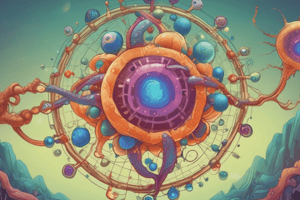Podcast
Questions and Answers
What is the main component of chromatin in a non-dividing cell?
What is the main component of chromatin in a non-dividing cell?
- Only histone proteins
- RNA and histone proteins
- DNA and histone proteins
- DNA, RNA and histone proteins (correct)
Approximately how long is the DNA molecule in a human cell?
Approximately how long is the DNA molecule in a human cell?
- 2 metres (correct)
- 4 metres
- 1 metre
- 3 metres
What is the term for the DNA found outside the nucleus in mitochondria and chloroplasts?
What is the term for the DNA found outside the nucleus in mitochondria and chloroplasts?
- Intranuclear DNA
- Extranuclear DNA (correct)
- Nuclear DNA
- Mitochondrial DNA
What is the shape of the DNA molecule?
What is the shape of the DNA molecule?
What are the building blocks of DNA?
What are the building blocks of DNA?
What is the role of the four nitrogenous bases in DNA?
What is the role of the four nitrogenous bases in DNA?
What type of bonds hold the sugar and phosphate molecules together in DNA?
What type of bonds hold the sugar and phosphate molecules together in DNA?
What is the rule for the pairing of adenine and thymine in DNA?
What is the rule for the pairing of adenine and thymine in DNA?
What is the key characteristic that distinguishes purines from pyrimidines?
What is the key characteristic that distinguishes purines from pyrimidines?
What is the reason for the genetic code being different between organisms?
What is the reason for the genetic code being different between organisms?
What is the primary function of DNA in an organism?
What is the primary function of DNA in an organism?
What percentage of human DNA codes for proteins?
What percentage of human DNA codes for proteins?
What is the term for the non-coding regions of DNA?
What is the term for the non-coding regions of DNA?
What is the purpose of DNA replication?
What is the purpose of DNA replication?
What is unique about the sequence of nucleotides in identical twins?
What is unique about the sequence of nucleotides in identical twins?
What is the relationship between the complexity of an organism and the amount of non-coding DNA it contains?
What is the relationship between the complexity of an organism and the amount of non-coding DNA it contains?
Flashcards are hidden until you start studying
Study Notes
Where is DNA Found?
- DNA is mainly found in the nucleus of a cell, forming part of the chromatin network.
- Small amounts of DNA are also found outside the nucleus in mitochondria and chloroplasts, known as extranuclear DNA.
Structure of DNA
- DNA is a long, twisted ladder-like molecule that forms a stable, 3-dimensional double helix.
- The DNA molecule is made up of nucleotides, which are building blocks consisting of a sugar molecule, a phosphate molecule, and a nitrogenous base.
Nucleotides
- There are four types of nitrogenous bases: adenine (A), thymine (T), guanine (G), and cytosine (C).
- These four bases are the foundation of the genetic code, instructing cells on how to synthesize enzymes and other proteins.
Double Helix Structure
- The outer two strands of the ladder are formed by a chain of alternating sugar and phosphate links.
- The rungs of the ladder are formed from pairs of bases linked by weak hydrogen bonds.
- The base pairs are attached to the sugar molecules.
Base Pairing
- Adenine (A) pairs with thymine (T) or uracil (U) using two hydrogen bonds.
- Cytosine (C) pairs with guanine (G) using three hydrogen bonds.
Classification of Nitrogenous Bases
- There are two groups of nitrogenous bases: purines and pyrimidines.
- Purines consist of two fused rings of nitrogen, carbon, and hydrogen atoms (e.g. guanine and adenine).
- Pyrimidines consist of one ring of similar atoms and are smaller than purines (e.g. cytosine and uracil).
Universality of DNA
- The four nucleotides are the same in all animals and plants.
Genetic Code
- The sequence of nucleotides determines the genetic code of an organism.
- The sequence of nucleotides in certain sections of DNA in a human is different from the same sections in every other human being (except in identical twins).
Role of DNA
- DNA molecules carry hereditary information in the form of genes.
- DNA provides a blueprint for an organism's growth and development by coding for protein synthesis.
- DNA can replicate, making a copy of itself to pass on genetic information to each daughter cell during cell division.
Non-Coding DNA
- Less than 2% of human DNA codes for proteins; the rest consists of non-coding DNA.
- Non-coding regions are interrupted by protein-coding regions called exons.
- Complex organisms contain more non-coding DNA than less complex organisms.
Studying That Suits You
Use AI to generate personalized quizzes and flashcards to suit your learning preferences.




